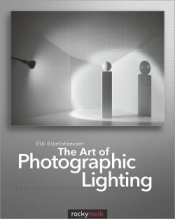 A good number of people that hold an interest in firearms also have an interest in photography. Firearms project a variety of personalities, some associated with the machinery, some associated with their typical owners. Context photography of firearms requires identifying, accommodating and visually prioritizing those differences. It isn’t easy. I know, because I am lousy at it, but I do try to make improvements and that’s where this book is helpful.
A good number of people that hold an interest in firearms also have an interest in photography. Firearms project a variety of personalities, some associated with the machinery, some associated with their typical owners. Context photography of firearms requires identifying, accommodating and visually prioritizing those differences. It isn’t easy. I know, because I am lousy at it, but I do try to make improvements and that’s where this book is helpful.
The Art of Photographic Lighting is not like any of the two hundred photography books that I’ve purchased, hoped to find useful, then discounted as no more than a collection of someone’s pretty pictures. The Art of Photographic Lighting is a solid reference book, supported by foundation and extensive examples of applications. It is better as a subject text than most formal course study.
The book opens with a section titled “Light is Perception”, which sounds a little… out there, but the statement “Light is the raw material of perception, making light and thought inseparable. Without light, we can not perceive; there would be no shade, no shape, no color, and, to the end, there would be no images” is relatively profound. The statement, “…light, per se, is invisible and can only be perceived once it interacts with objects that reflect it.” caused me to step back from lights, shutters and lenses and to take a fresh look at what I was trying to accomplish. It was like the 60’s all over again. I was having a cosmic experience and in search of a greater truth, but it got me to pull up the equipment set up tape marks and that was fun.
Practical Magic
Fortunately, The Art of Photographic Lighting shifts from a more conceptual opening to a very practical and detailed dissection of natural and artificial lighting of every major technology type and sub category. Each type of lighting’s strengths and weaknesses is indicated, as well as the typical photographic applications. Following this detail is a large section that addresses color temperature, the nature of light and shade and methods and basis for controlling all through the managed use of: reflection, diffusion, hard light, soft light, umbrellas, soft boxes, ring lights, color infusion, light painting and, of course, natural light.
Along with each presentation is an illustration of the type of light and shadow a combination of tools and techniques will produce. Some of the referenced tools are expensive, some are downright cheap. In many instances, techniques are shown to get the same results from natural light that one would think required artificial light. Patience seemed to be the added ingredient. Half an hour of reading offered enough insight for me to change my approach to an active project to a more correct approach that requires only 10% of the original planned expenditure.
So now my copy of The Art of Photographic Lighting is sitting on my studio work table, dog eared and marked up. It is a tool for every day use by photographers of virtually every skill level, amateur or professional. I think the book will have a direct impact on the quality and creative components of my work and that’s pretty exciting. The book is not going to teach me all there is to know about lighting, but it is going to help make me a better photographer in a meaningful way.
The author of the book, Eib Eibelshaeuser holds a Master of Fine Arts degree and is currently a faculty member at the University of Applied Sciences, Duesseldorf, Germany. This effort required to produce this book was not one that could be terms casual.

Email Notification